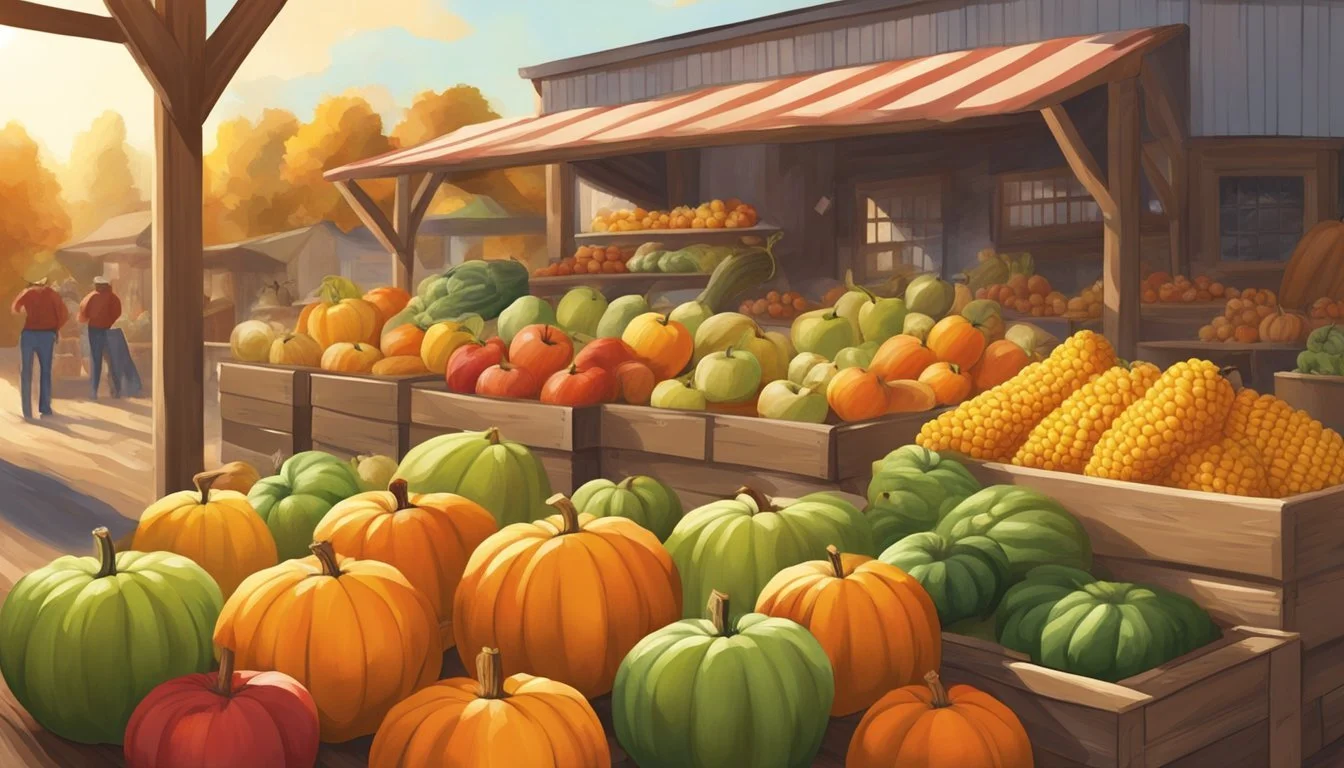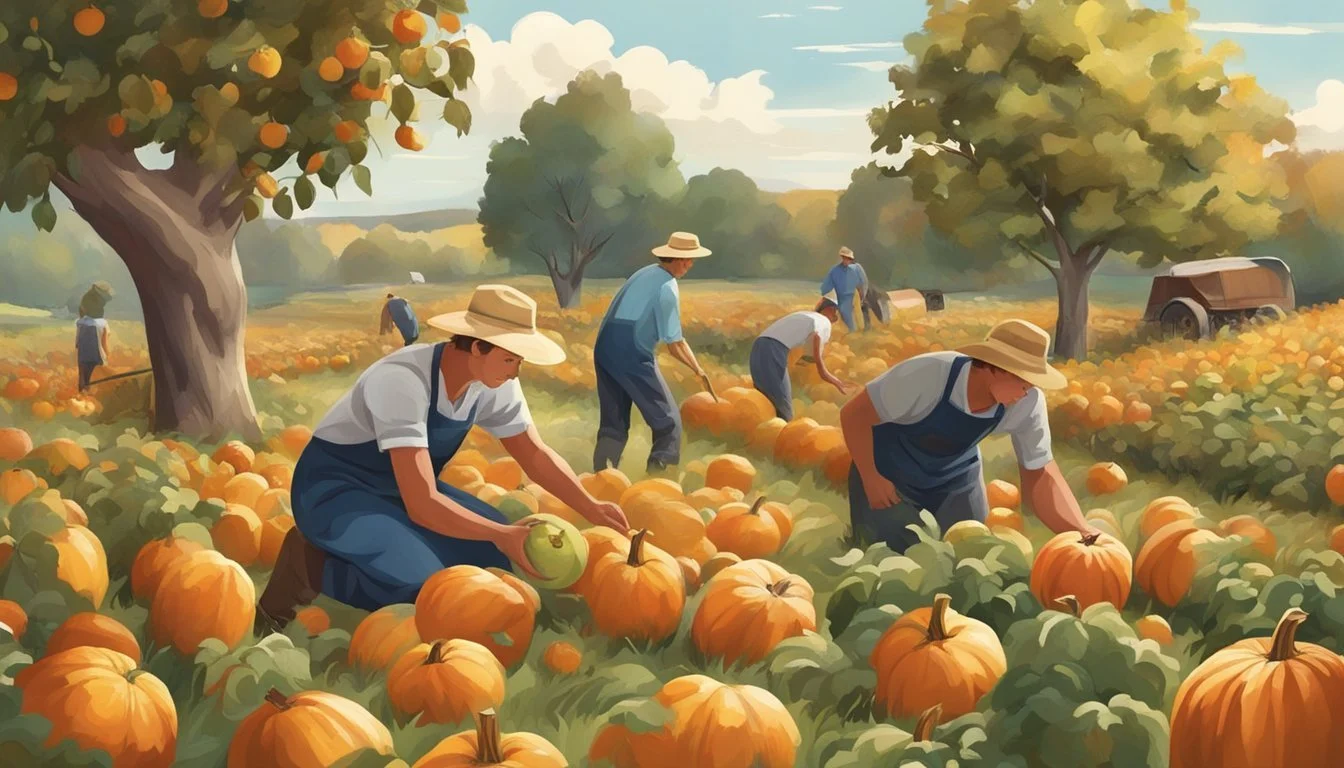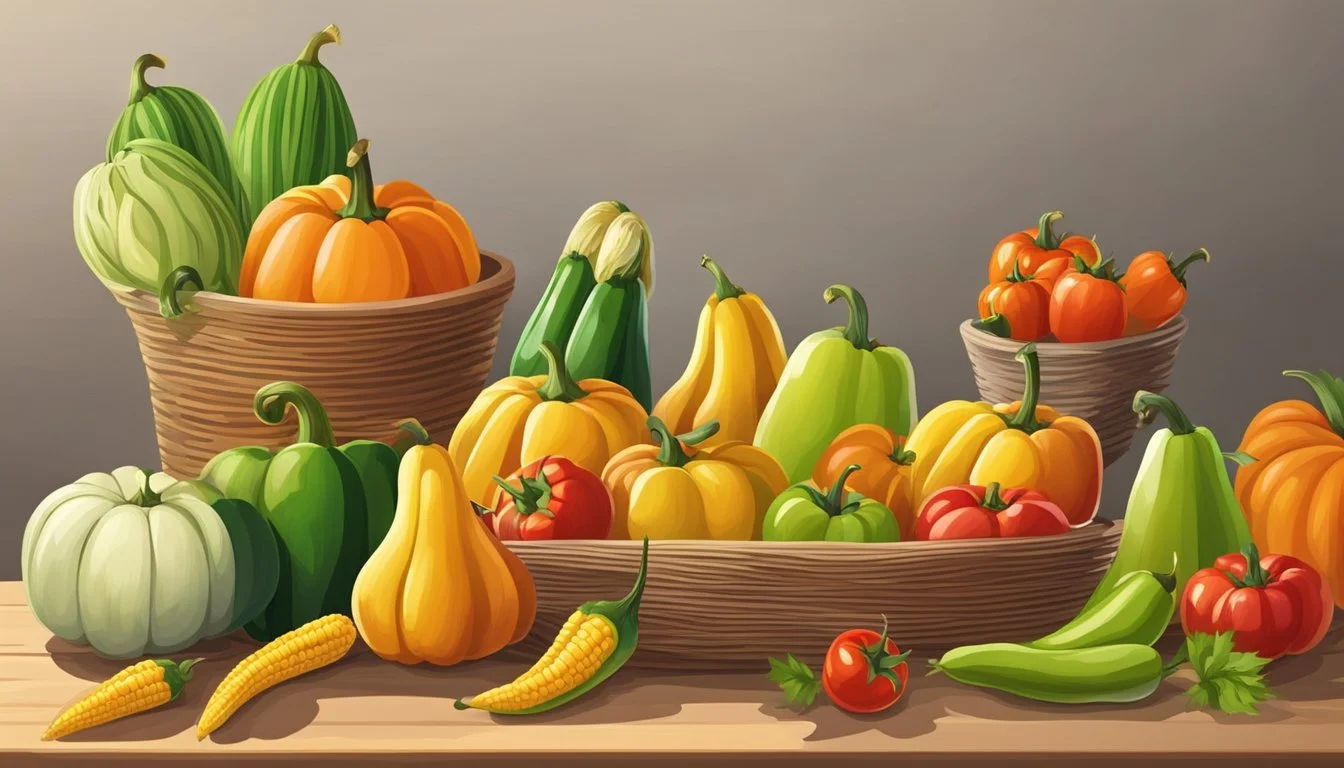Massachusetts Seasonal Fruit & Vegetables in September
Your Fresh Produce Guide
This Article is Part of our Massachusetts Seasonal Fruit & Veg Calendar
Massachusetts bursts into a tapestry of colors in September as the state transitions into fall. This change in season is not just a visual treat but also a cue for a shift in the local produce available. The temperate climate of the region supports a range of fruits and vegetables that reach their peak during this month.
The variety of produce available in September is a testament to the region's rich agricultural heritage. Apples, for instance, take center stage with varieties such as McIntosh, Ginger Gold, Honey Crisp, and Macoun being harvested. The orchards offer a delightful experience for those who partake in the popular activity of apple picking. On the vegetable front, leafy greens like arugula and chard continue to grow well into fall, while root vegetables, such as carrots (how long do carrots last?) and beets (how long do beets last?), become more prominent.
September's bounty is rounded out by the last of the summer vegetables like corn-on-the-cob and tomatoes, complemented by the arrival of early fall produce like pumpkins and squashes. These ingredients offer an array of flavors and textures to play with in the kitchen, from the last hurrah of summer salads to the heartier comfort dishes that herald the coming cooler months.
Overview of Massachusetts Seasonal Produce
In Massachusetts, September marks a time when a wide variety of fruits and vegetables reach their peak of harvest. Knowing what is available can guide shoppers to the freshest produce and support local farming.
Seasonal Varieties
Fruits:
Apples: A staple of Massachusetts fall, varieties like McIntosh and Ginger Gold are prevalent.
Pears: Both European and Asian pears are typically ripe for picking.
Grapes: September is the beginning of grape season in the state.
Plums: Find several varieties of plums at their peak.
Vegetables:
Broccoli: Cool weather ushers in a great harvest of broccoli.
Carrots: Carrot varieties thrive and are harvested this month.
Cabbage: Known for its sturdiness, it’s a good yield in September.
Potatoes: Several varieties like baking and new potatoes are available.
Leeks: This mildly sweet onion relative is typically harvested.
Pumpkins: They begin to be available, signaling the approach of autumn.
Importance of Eating Seasonally
Eating seasonally means enjoying produce at its freshest, which can lead to better taste and nutrition. Seasonal consumption supports local agriculture and reduces the environmental footprint associated with long-distance transportation of food. In Massachusetts, September's harvest offers a wealth of options that reflect the region's agricultural diversity and the changing seasons.
Fruits Available in September
September in Massachusetts presents an abundance of fruit harvests, offering a diverse range of flavors from the sweet and juicy to the delightfully tart. This is the prime time for fruit lovers to enjoy the freshest local produce.
Apples
Massachusetts apple orchards are bountiful with a variety of apples during September. They range from the classic 'Honey Crisp', known for its sweet flavor and crisp bite, to the 'Macoun' and 'Cortland', offering a slightly tart taste perfect for baking and making jam. Other varieties like 'Empire' and 'Golden Delicious' also make their seasonal debut, each with their distinct flavors and uses.
Honey Crisp: Sweet, ideal for snacking
Macoun: Tart, excellent for apple pies
Cortland: Slightly tart, great for salads and sauces
Berries
While the berry season is winding down, one can still find late-harvest raspberries in local markets. These berries are prized for their intense flavor and are perfect for fresh eating or for making jams and preserves.
Raspberries: Bold and tart, suitable for jam-making
Stone Fruits
Early September is often the last call for stone fruits like peaches and plums. These fruits are known for their juicy flesh and can be eaten fresh or used in various culinary preparations, from cobblers to chutneys.
Peaches: Juicy and sweet, commonly used in desserts
Plums: Sweet with a hint of tartness, versatile in both sweet and savory dishes
Melons
Melons, still available in early September, provide a refreshing and hydrating option for end-of-summer picnics and gatherings. They come in several varieties, with cantaloupes (how long does cantaloupe last?) and honeydews being the most popular, each offering a uniquely sweet and mellow taste.
Cantaloupes: Rich and sweet, perfect for fruit salads
Honeydews: Subtly sweet, best served chilled
The month of September elevates the pleasure of fresh fruit, with each variety offering delightful flavors and textures that resonate with the changing seasons. Whether incorporated into recipes or enjoyed on their own, these fruits are a testament to Massachusetts's rich agricultural offerings.
Vegetables Available in September
September in Massachusetts yields an abundant harvest of vegetables, with a broad array of varieties reaching their peak. This month is known for offering fresh, flavorful produce that can be eaten raw or transformed through cooking methods like roasting.
Root Vegetables
Root vegetables come into their prime, delivering a nutritious and flavorful punch to the fall menu. Harvests include:
Carrots: Crunchy and sweet, perfect for salads or roasting.
Beets: Rich and earthy, suitable for both raw and cooked dishes.
Radishes: Peppery and crisp, they add a zesty flair when served raw.
Squashes
A variety of squashes are available which are versatile in culinary uses.
Butternut: Sweet and nutty, ideal for soups and stews.
Acorn: Mild taste, can be baked or stuffed.
Pumpkins: Not just for decoration, they're great in pies and other baked goods.
Leafy Greens
Leafy greens are thriving, offering a wealth of nutrients and flavors.
Kale: Sturdy and slightly bitter, it stands up well to cooking.
Arugula: Peppery, often used raw in salads.
Chard: Colorful and nutrient-rich, good for sautéing or salads.
Spinach: Tender and slightly sweet, versatile for many dishes.
Nightshades
Nightshade vegetables are in full swing, offering rich flavors and a variety of uses.
Peppers: From sweet to hot, they can be roasted, stuffed, or used raw.
Tomatoes: Juicy and ripe, essential for salads, sandwiches, and sauces.
Eggplant: Meaty texture makes it suitable for grilling, baking, or frying.
Harvesting Techniques and Tips
September in Massachusetts is a peak time for harvesting a variety of fruits and vegetables. The right techniques and timing are crucial for ensuring the best quality and longevity of the produce.
Picking The Right Time to Harvest
The key to a successful harvest is identifying the optimal time when fruits and vegetables are at their peak in terms of flavor and texture. Apples should be harvested when they are firm to the touch and have attained their characteristic color for the specific variety. They often come off the branch with a gentle upward twist. Leafy greens like lettuce should be picked when they are crisp and full, but before they start to brown or wilt.
Vegetables such as squash and pumpkins are ready when they have a deep, rich color and a hard rind. Test for ripeness by gently pressing a fingernail against the skin; if it doesn’t puncture, the vegetable is ready. A light frost can actually enhance the sweetness of some produce, but be sure to harvest before a heavy frost to avoid damage.
Techniques for Picking and Storing
After determining the right time for harvest, employ the proper techniques for picking and storing to maintain quality. Fruits should be gently twisted or snipped from the plant to prevent damage to the produce and the tree or vine itself. Vegetables must be lifted or cut carefully from the ground, taking care not to bruise or cut the edible parts.
For storage, maintain the freshness of fruits and vegetables in a cool, dark place. Most harvested produce benefits from refrigeration, ideally in a crisper drawer of the refrigerator. However, items like squash and pumpkins should be kept in a cool, dry area. Fruits and vegetables should be stored in breathable materials, and not in airtight containers, to prevent accelerated spoilage. For long-term storage, some produce can be blanched and frozen, canned, or dried.
Health Benefits of Seasonal Eating
Eating seasonally offers numerous health benefits that are quintessential for maintaining a balanced diet. During September in Massachusetts, a wealth of fruits and vegetables reach their peak, providing an optimal balance of flavor and nutritional value.
Nutritional Value: Seasonally fresh produce is often at its nutritional best. Fruits and vegetables picked and consumed at their peak generally contain more vitamins, minerals, and antioxidants. These nutrients are crucial for a healthy immune system, robust growth and development, and preventing chronic diseases.
Freshness: When fruits and vegetables are eaten in season, they are fresher and, as a result, often taste better. This is because seasonal produce can be harvested at the right time and doesn't require long distances for transport, which can deplete its freshness. For example, the crispness of an apple or the sweet flavor of a September tomato is unmatched when it comes from a local Massachusetts farm.
Flavor:
Apples: Sweet and tangy, perfect for ciders and pies
Pumpkins: Earthy sweetness, ideal for soups and desserts
Tomatoes: Juicy and vibrant, enhances salads and sauces
When individuals choose to eat seasonally, they are also supporting local farming, which contributes to sustainable agricultural practices and the local economy. With each bite of local and seasonally ripe produce, consumers receive a taste that is both nourishing and a reflection of the environment that cultivated it.
Culinary Uses and Recipes
In September, Massachusetts' harvest yields an array of produce perfect for both fresh consumption and preservation. This versatility allows for a myriad of culinary uses, especially for turning fruits like apples into sweet treats or savory salsas and vegetables into satisfying sides or main courses.
Preserving Techniques
Applesauce: Making applesauce is a simple process. Peeling and coring apples, then cooking them down with a hint of cinnamon, creates a classic preserve that can be canned or refrigerated.
Salsa: Fresh tomatoes can be chopped and mixed with onions, cilantro, and spicy peppers to create a tangy salsa. This mixture can be canned following proper safety procedures to enjoy year-round.
Jam: Berries, with their peak season ending, are ideal for jam-making. Cooked down with sugar and pectin (how long does pectin last?), then properly canned, they capture the essence of Massachusetts autumn.
Recipe Ideas
Salad:
Apple Walnut Salad: Combine spinach, sliced apples, walnuts, and a vinaigrette dressing for a fresh, sweet and tart salad.
Hearty Vegetable Salad: Roast beets and carrots, then toss them with arugula, goat cheese, and a balsamic reduction.
Sweet:
Baked Apples: Core apples and stuff them with a mixture of oats, cinnamon, and brown sugar, then bake until tender.
Apple Crisp: Slice apples and layer them under a crumbly topping of butter, flour, and sugar, baking until golden and bubbly.
Tart:
Plum Tart: Arrange sliced plums atop a pastry crust, sprinkle with sugar, and bake until the crust is crisp and the plums are juicy.
Tomato Tart: Layer tomatoes, cheese, and herbs over a savory pastry base and bake until the tomatoes are caramelized and the crust is flaky.
Both preserving techniques and fresh recipes allow one to make the most of Massachusetts' September produce, whether it's the tang of a fresh salsa, the comfort of a warm apple crisp, or the vibrancy of a mixed vegetable salad.
Local Farming and Economic Impact
In Massachusetts, the support of local farming is a vital component of the state's agriculture industry, with significant economic benefits. Through initiatives aimed at improving efficiency and accessibility, the state bolsters its local food system, with a particular impact on the economy.
Supporting Local Farmers
Investments in local farming initiatives help Massachusetts farmers extend their growing seasons and enhance the availability of fresh produce. This includes constructing infrastructure such as hoop houses, enabling the growth of cold-weather crops like Lacinato kale and Hakurei turnips. By supporting local farmers, residents gain access to fresh, locally-produced food throughout the year, fostering a closer connection between consumers and their food sources.
Season Extension: Farmers utilize advanced techniques to grow seasonal produce such as arugula, scallions, and lettuce into September and beyond.
Infrastructure Development: Local processing centers, like the one in Greenfield, allow farmers to freeze and process fruits and vegetables, adding value to their products.
Agricultural Economy
The Massachusetts agricultural economy benefits directly from the local farming sector. For every $1 million in revenue produced by farms engaged in direct marketing, nearly 32 jobs are created. This is a significant increase compared to the 10.5 jobs typically generated by produce farms that solely engage in wholesale channels.
Job Creation: Direct marketing strategies employed by local farmers result in higher job creation, embedding the industry firmly into the state's economic fabric.
Local Investment: State-funded programs inject $58 million into making the local food system more resilient and connected, sustaining the agricultural economy through ups and downs.
Seasonal Farming Challenges
As the growing season in Massachusetts progresses into September, farmers must anticipate and manage various challenges to ensure the availability of cool-weather crops. The two most impactful factors they contend with are weather variability and pests.
Weather Factors
In September, farmers in Massachusetts often face the unpredictable nature of transitioning weather patterns. While the early part of the month can still hold the warmth of summer, cooler temperatures typically set in as the month progresses. This change can affect the growing season and crop health, particularly for temperature-sensitive varieties. It's critical for farmers to monitor weather forecasts vigilantly and prepare for:
Frost: An early frost can severely impact or even end the growing season prematurely.
Heavy Rainfall: Too much rain can lead to flooding, which may damage crops and limit their availability.
Pest Management
With the onset of cooler September weather, pest populations can either increase or decrease, posing different challenges for crop protection. The following are common concerns:
Insects: Some pests thrive in the cooler temperatures, necessitating vigilant monitoring and management.
Disease: Fungal diseases often propagate in the damp, cooler conditions of early fall.
Farmers utilize integrated pest management strategies to handle these issues, aiming to safeguard the availability of cool-weather crops such as lettuce, carrots, and pumpkins, without relying excessively on chemical interventions.










